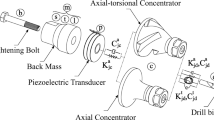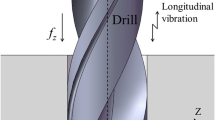Abstract
Ultrasonic vibration-assisted drilling, which can obtain the minimization of geometrical defects, provides a solution for the drilling of carbon fiber-reinforced plastic (CFRP) by adding a displacement of a micro-scale amplitude with a frequency to the tool tip. However, single vibration mode in drilling of CFRP cannot satisfy the different requirements of various drilling stages in CFRP and limits the applications of current ultrasonic vibration-assisted drilling of CFRP. To overcome the limitation and improve the performance of vibration-assisted drilling process in CFRP components, a novel variant-dimension vibration-assisted drilling system (VD-VADS) is proposed. The VD-VADS is specially designed to be capable of delivering variant-dimension vibrations at the tool tip for drilling holes in CFRP by producing one-dimension longitude vibration, two-dimension elliptic vibration, and three-dimension composite vibration, which can be transferred to adapt to various drilling stages in CFRP. An analytical model of the VD-VADS’s locus will be formulated to facilitate the prediction of the loci of the tooltip and design and realization of the prototype device. The control strategy of variant-dimension vibration mode of the proposed VD-VADS is established and realized for various drilling stages in CFRP. To validate the machining performance of the VD-VADS, five groups of drilling experiments under the conventional drilling and various vibration-assisted drilling processes were performed. The performance tests and comparison results of the obtained holes between the conventional drilling and various vibration-assisted drilling processes indicate that the proposed VD-VADS is capable of generating holes with better overall quality than the current single vibration-assisted drilling processes.





















Similar content being viewed by others
Data availability
Not applicable.
Code availability
Not applicable.
References
MSaoubi R, Axinte D, Soo SL, Nobel C, Attia H, Kappmeyer G, Engin S, Sim WM (2015) High performance cutting of advanced aerospace alloys and composite materials. CIRP Ann Manuf Technol 64:557–580
Pramanik A, Basak A, Dong Y, Sarker PK, Uddin MS, Littlefair G, Dixit AR, Chattopadhyaya S (2017) Joining of carbon fibre reinforced polymer (CFRP) composites and aluminium alloys-A review. Compos A: Appl Sci Manuf 101:1–29
Vigneshwaran S, Uthayakumar M, Arumugaprabu V (2018) Review on machinability of fiber reinforced polymers: a drilling approach. Silicon 10(5):2295–2305
Abrao AM, Faria PE, Rubio JCC, Reis P, Davim JP (2007) Drilling of fiber reinforced plastics: a review. J Mater Process Technol 186(1):1–7
Geier NJ, Davim JP, Szalay T (2019) Advanced cutting tools and technologies for drilling carbon fibre reinforced polymer (CFRP) composites: a review. Compos A: Appl Sci Manuf 125:105552
Girot F, Dau F, Gutiérrez-Orrantia ME (2017) New analytical model for delamination of CFRP during drilling. J Mater Process Technol 240:332–343
Wang X, Kwon PY, Sturtevant C, Kim D, Lantrip J (2013) Tool wear of coated drills in drilling CFRP. J Manuf Process 15(1):127–135
Ferreira JR, Coppini NL, Levy NF (2001) Characteristics of carbon–carbon composite turning. J Mater Process Technol 109(1–2):65–71
Khan MA, Kumar S (2011) Machinability of glass fibre reinforced plastic (GFRP) composite using alumina-based ceramic cutting tools. Int J Manuf Process 13:67–73
Tsao CC (2008) Experimental study of drilling composite materials with step-core drill. Mater Des 29(9):1740–1744
Tsao CC, Huang CC (2015) Analysis of thrust-induced drilling in composite materials using a hemispherical drill. Int J Adv Manuf Technol 80(1):607–613
Liu J, Chen G, Ji C, Qin X, Li H, Ren C (2014) An investigation of workpiece temperature variation of helical milling for carbon fiber reinforced plastics (CFRP). Int J Mach Tool Manu 86(11):89–103
Bao Y (2012) Research on temperature field model during grinding-drilling of unidirectional carbon/epoxy composites. J Mech Eng 48(1):169
Hochen H, Hsu CC (1995) Preliminary study of ultrasonic drilling of fibre-reinforced plastics. J Mater Process Technol 48(1):255–266
Cong WL, Pei ZJ, Deines TW, Liu DF, Treadwell C (2013) Rotary ultrasonic machining of CFRP/Ti stacks using variable federate. Compos Part B 52:303–310
Ladonne M, Cherif M, Landon Y, Knevez JY, Cahuc O, Castelbajac CD (2015) Modelling the vibration-assisted drilling process: identification of influential phenomena. Int J Adv Manuf Technol 81:1657–1666
Nikbakt S, Kamarian S, Shakeri M (2018) A review on optimization of composite structures. Part I: laminated composites. Compos Struct 195:158-185
Feng Q, Cong WL, Pei ZL, Ren CZ (2012) Rotary ultrasonic machining of carbon fiber-reinforced polymer: feasibility study. Mach Sci Technol 16(3):380–398
Ning FD, Cong WL, Pei ZJ, Treadwell C (2016) Rotary ultrasonic machining of CFRP: a comparison with grinding. Ultrasonics 66:125–132
Baraheni M, Amini S (2019) Comprehensive optimization of process parameters in rotary ultrasonic drilling of CFRP aimed at minimizing delamination. Int J Lightweight Mater Manuf. https://doi.org/10.1016/j.ijlmm.2019.03.003
Wang JJ, Feng PF, Zhang JF, Guo P (2018) Reducing cutting force in rotary ultrasonic drilling of ceramic matrix composites with longitudinal-torsional coupled vibration. Manuf Lett 18:1–5
Geng DX, Lu Z, Yao G, Liu J, Li Z, Zhang DY (2017) Cutting temperature and resulting influence on machining performance in rotary ultrasonic elliptical machining of thick CFRP. Int J Mach Tool Manu 123:160–170
Geng DX, Liu YH, Shao ZY, Zhang ML, Jiang XG, Zhang DY (2020) Delamination formation and suppression during rotary ultrasonic elliptical machining of CFRP. Compos Part B 183:107698
Liu J, Zhang DY, Qin LG, Yan LS (2012) Feasibility study of the rotary ultrasonic elliptical machining of carbon fiber reinforced plastics (CFRP). Int J Mach Tool Manu 53:141–150
Zhao B, Bie WB, Wang XB, Chen F, Chang B (2019) Design and experimental investigation on longitudinal-torsional composite horn considering the incident angle of ultrasonic wave. Int J Adv Manuf Technol 105:325–341
Shamoto E, Suzuki N, Tsuchiy E, Hori Y, Inagaki H, Yoshino K (2005) Development of 3 DOF ultrasonic vibration tool for elliptical vibration cutting of sculptured surfaces. CIRP Ann Manuf Technol 54:321–324
Lin JQ, Zhou XQ, Li YC (2014) Tool path generation for fabricating optical freeform surfaces by non-resonant 3D elliptical vibration cutting. Proc Inst Mech Eng C J Mech Eng Sci 228:1208–1222
Zhang C, Lu M (2018) A novel variable-dimensional vibration-assisted actuator for drilling CFRP. Int J Adv Manuf Technol 99(9-2):3049–3063
Funding
This paper was funded by the Natural Science Foundation of China (NSFC) under grant no 51675277 and by the High-Level Talents Project of “six talents summit” in Jiangsu under grant number GDZB-011.
Author information
Authors and Affiliations
Contributions
The contribution of this paper is that the VD-VADS is specially designed to be capable of delivering variant-dimension vibrations at the tool tip for drilling holes in CFRP by producing one-dimension longitude vibration, two-dimension elliptic vibration, and three-dimension composite vibration, which can be transferred to adapt to various drilling stages in CFRP and an analytical model of the VD-VADS’s locus will be formulated to facilitate the prediction of the loci of the tooltip and design and realization of the prototype device. The control strategy of variant-dimension vibration mode of the proposed VD-VADS is established and realized for various drilling stages in CFRP.
Corresponding author
Ethics declarations
Ethics approval
We further confirm that any aspect of the work covered in this manuscript that has involved either experimental animals or human patients has been conducted with the ethical approval of all relevant bodies and that such approvals are acknowledged within the manuscript.
Consent to participate
We confirm that the manuscript has been read and approved by all named authors and that there are no other persons who satisfied the criteria for authorship but are not listed. We further confirm that the order of authors listed in the manuscript has been approved by all of us.
Consent for publication
We confirm that we have given due consideration to the protection of intellectual property associated with this work and that there are no impediments to publication, including the timing of publication, with respect to intellectual property. In so doing, we confirm that we have followed the regulations of our institutions concerning intellectual property.
Conflict of interest
The authors declare no competing interests.
Additional information
Publisher’s note
Springer Nature remains neutral with regard to jurisdictional claims in published maps and institutional affiliations.
Supplementary Information
ESM 1
(DOCX 51 kb)
Rights and permissions
About this article
Cite this article
Zhang, C., Lu, M. Investigation on a novel variant-dimension vibration-assisted drilling system for CFRP: locus model, control strategy, and machining experiments. Int J Adv Manuf Technol 113, 2629–2650 (2021). https://doi.org/10.1007/s00170-021-06744-w
Received:
Accepted:
Published:
Issue Date:
DOI: https://doi.org/10.1007/s00170-021-06744-w




